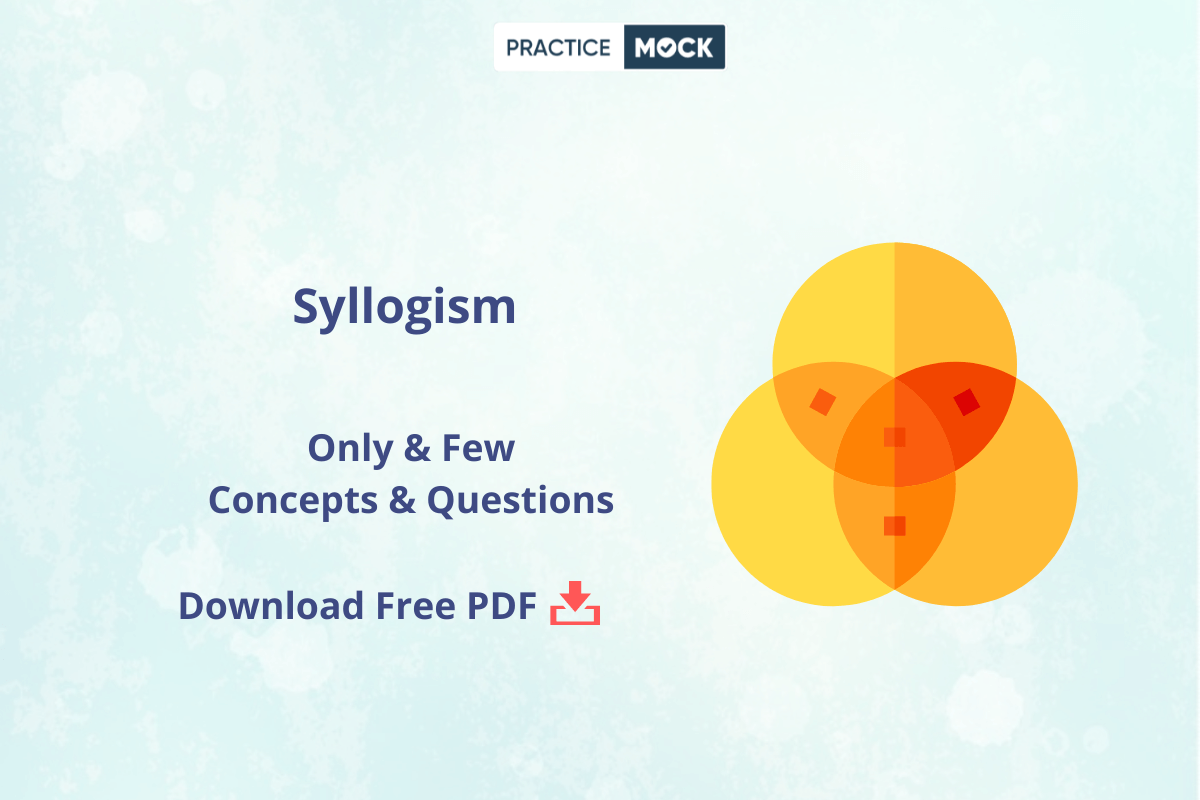Syllogism is generally considered a difficult topic by banking aspirants. From the past banking exams, it’s been observed that syllogism questions based on ‘Only & Few’ are repetitively asked. Some aspirants tend to ignore this topic and lose precious marks. But it should be remembered that even a single mark is very important in banking exams. Therefore to help you with the ‘only & few’ cases of this topic we have come up with a comprehensive article which will clear all your doubts. We have explained different scenarios of ‘only & few’ cases of syllogism along with examples. Not only this, but we have also provided you with questions (with explanation) for practice.

Seating Arrangement Tips & Questions for Practice- Download PDF
Let’s get started with the different scenarios of only & few cases of syllogism
Syllogism- Only & Few- Statements & Valid Conclusions
A. Statements:
Only few A are B
Some B are C
Conclusions:
Conclusion I. All A being B is a possibility: Doesn’t Follow

Or

As only few A are B, all A cannot be B.
Conclusion II. No A being B is a possibility: Doesn’t Follow

Or

Some A has to be B.
Conclusion III. All B being A is a possibility: Follows
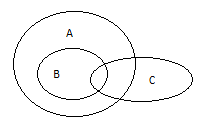
Or

As there are two possibilities, all B may be A.

Conclusion IV. Some A are not B: Follows

Or

As only few A are B, so some A are definitely not B.
Conclusion V. Some A not being B is a possibility: Doesn’t Follow

Or

Only few A are B, it means that some A are definitely not B and it is not a possibility, it is definitely true.
Conclusion VI. Some B are not A: Doesn’t Follow

Or

In 1st possibility, all B are A while in 2nd possibility, some B are not A.
Conclusion VII. Some B not being A is a possibility: Follows

Or

In 1st possibility, all B are A while in 2nd possibility, some B are not A.
Conclusion VIII. Some A are not C: Doesn’t Follow
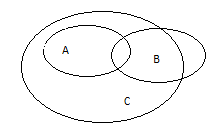
Or

All A are C is 1st possibility. So, it doesn’t follow.
B. Statements:
Only C are T (It means that all T are C and no other element is T, and there will be no intersection)
Some C are B
Conclusions:
Conclusion I. Some B can be T: Doesn’t Follow
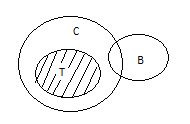
No B is T.
Conclusion II. All B can be C: Follows
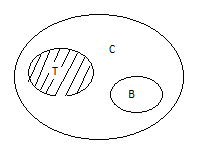
As some C are B, all B can be C.
Conclusion III. All C can be B: Doesn’t Follow
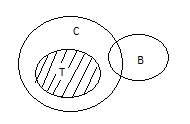
As T cannot be B, so all C cannot be B
Conclusion IV. Some T not being C is a possibility: Doesn’t Follow and is false
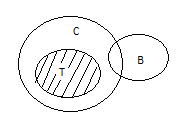
All T are C, so some T not being C is not at all possible.
Conclusion V. No T is B: Follows

Only C are T, so T is not B.

📥 PDF- Syllogism- Only & Few Concepts & Questions
Weekly Current Affairs- Download Free PDF
Syllogism- Only & Few- Questions for Practice (with Explanatory Answers)
Question 1: In the question below there are three statements followed by two conclusions I and II. You have to take the three given statements to be true even if they seem to be at variance from commonly known facts and then decide which of the given conclusions logically follows from the four statements disregarding commonly known facts.
Statements:
No fingers are legs
Mostly legs are hands
Only a few hands are hairs
Conclusions:
I. Some legs are not hairs
II. All hands being fingers is a possibility.
a. Only conclusion II follows
b. Neither conclusion I nor conclusion II follows
c. Only conclusion I follows
d. Both conclusion I and conclusion II follow.
e. None of the above
Answer: For Detailed Solution, download the Free PDF
Question 2: In the question below there are three statements followed by two conclusions I and II. You have to take the three given statements to be true even if they seem to be at variance from commonly known facts and then decide which of the given conclusions logically follows from the four statements disregarding commonly known facts.
Statements:
Few bottles are mugs.
All mugs are jugs.
Mostly jugs are buckets
Conclusions:
I. Only mugs are buckets
II. Few bottles are jugs
a. Both conclusion I and conclusion II follow.
b. Only conclusion II follows
c. Neither conclusion I nor conclusion II follows
d. Only conclusion I follows
e. None of the above
Answer: For Detailed Solution, download the Free PDF

Important Days/Dates 2021-22 with Themes for Banking/ SSC/ RRB NTPC/ Govt. Exams
Question 3: In the question below there are three statements followed by two conclusions I and II. You have to take the three given statements to be true even if they seem to be at variance from commonly known facts and then decide which of the given conclusions logically follows from the four statements disregarding commonly known facts.
Statements:
Only rivers are seas
Few lakes are rivers
Few oceans are lakes
Conclusions:
I. Some seas being lakes is a possibility
II. Some rivers being oceans is a possibility
a. Only conclusion II follows
b. None of the above
c. Neither conclusion I nor conclusion II follows
d. Both conclusion I and conclusion II follow.
e. Only conclusion I follows
Answer: For Detailed Solution, download the Free PDF
Question 4: In the question below are given three statements followed by two conclusions numbered I and II. You have to take the given statements to be true even if they seem to be at variance from commonly known facts. Read all the conclusions and then decide which of the given conclusions logically follows from the given statements disregarding commonly known facts.
Statements:
Only a few rides are trips.
No trip is mountain.
All mountains are trees.
Conclusions:
I: Some trees are not trips.
II: All rides being trips is not a possibility.
a. Only conclusion I follows
b. Only conclusion II follows
c. Either conclusion I or II follows
d. Both conclusions I and II follow
e. Neither conclusion I nor II follows
Answer: For Detailed Solution, download the Free PDF
Question 5: In the question below there are three statements followed by two conclusions I and II. You have to take the three given statements to be true even if they seem to be at variance from commonly known facts and then decide which of the given conclusions logically follows from the four statements disregarding commonly known facts.
Statements:
Mostly pets are cats
Only cats are dogs
No cats are rabbits
Conclusions:
I. Some pets are rabbits.
II. All pets being rabbits is not a possibility.
a. Both conclusion I and conclusion II follow.
b. Only conclusion I follows
c. Neither conclusion I nor conclusion II follows
d. Only conclusion II follows
e. None of the above
Answer: For Detailed Solution, download the Free PDF
Question 6: In the question below there are three statements followed by two conclusions I and II. You have to take the three given statements to be true even if they seem to be at variance from commonly known facts and then decide which of the given conclusions logically follows from the four statements disregarding commonly known facts.
Statements:
Few bulbs are tubelights
No tubelights are fans
Few fans are lights.
Conclusions:
I. Few lights are tubelights
II. All bulbs may be fans.
a. Only conclusion II follows
b. Both conclusion I and conclusion II follow.
c. Neither conclusion I nor conclusion II follows
d. Only conclusion I follows
e. None of the above
Answer: For Detailed Solution, download the Free PDF
Static GK- Download Free PDFs- For All Government, Banking Exams
Question 7: In the question below there are three statements followed by two conclusions I and II. You have to take the three given statements to be true even if they seem to be at variance from commonly known facts and then decide which of the given conclusions logically follows from the four statements disregarding commonly known facts.
Statements:
Only a few Sundays are Mondays.
Some Mondays are Tuesdays
No Tuesdays are Fridays
Conclusions:
I. Some Sundays are not Mondays
II. Some Sundays are not Fridays.
a. Both conclusion I and conclusion II follow.
b. Only conclusion I follows
c. Neither conclusion I nor conclusion II follows
d. Only conclusion II follows
e. None of the above
Answer: For Detailed Solution, download the Free PDF
Question 8: In the question below there are three statements followed by two conclusions I and II. You have to take the three given statements to be true even if they seem to be at variance from commonly known facts and then decide which of the given conclusions logically follows from the four statements disregarding commonly known facts.
Statements:
Some pencils are pens
Only pens are colours
Few pencils are erasers
Conclusions:
I. Few colours may be pencils
II. Few erasers are pens
a. Only conclusion II follows
b. None of the above
c. Neither conclusion I nor conclusion II follows
d. Both conclusion I and conclusion II follow.
e. Only conclusion I follows
Answer: For Detailed Solution, download the Free PDF

The Hindu Editorial Vocabulary- Download Free PDF
Question 9: In the question below there are three statements followed by two conclusions I and II. You have to take the three given statements to be true even if they seem to be at variance from commonly known facts and then decide which of the given conclusions logically follows from the four statements disregarding commonly known facts.
Statements:
Only few laptops are computers
No computers are keys
Few keys are mobiles
Conclusions:
I. Some mobiles are computers
II. All computers being laptops is a possibility
a. Only conclusion II follows
b. Neither conclusion I nor conclusion II follows
c. Only conclusion I follows
d. Both conclusion I and conclusion II follow
e. None of the above
Answer: For Detailed Solution, download the Free PDF
Question 10: In the question below there are three statements followed by two conclusions I and II. You have to take the three given statements to be true even if they seem to be at variance from commonly known facts and then decide which of the given conclusions logically follows from the four statements disregarding commonly known facts.
Statements:
Few rivers are ponds.
All ponds are oceans
No oceans are seas
Conclusions:
I. Few ponds can be seas
II. All rivers are oceans
a. Only conclusion II follows
b. None of the above
c. Neither conclusion I nor conclusion II follows
d. Both conclusion I and conclusion II follow.
e. Only conclusion I follows
Answer: For Detailed Solution, download the Free PDF
📥 PDF- Syllogism- Only & Few Concepts & Questions

This is all from us in this article. Download the Free PDF above and revise all the concepts of Syllogism- Only & Few cases. Also, check the detailed solution of questions related to Syllogism- Only & Few cases. We hope that this article will help you capitalize the precious marks of questions related to Syllogism.
Wishing you good luck with your preparation!
[table “16” not found /]- Sign Up on Practicemock for Updated Current Affairs, Free Topic Tests and Free Mini Mocks
- Sign Up Here to Download Free Study Material
Free Mock Tests for the Upcoming Exams
- IBPS PO Free Mock Test 2024
- RBI Grade B Free Mock Test 2024
- IBPS SO Free Mock Test 2024
- NABARD Grade A Free Mock Test 2024
- SSC CGL Free Mock Test 2024
- IBPS Clerk Free Mock Test 2024
- IBPS RRB PO Free Mock Test 2024
- IBPS RRB Clerk Free Mock Test 2024
- RRB NTPC Free Mock Test 2024
- SSC MTS Free Mock Test 2024
- SSC Strenographer Free Mock Test 2024
- GATE Mechanical Free Mock Test 2024
- GATE Civil Free Mock Test 2024
- RRB ALP Free Mock Test 2024
- SSC CPO Free Mock Test 2024
- AFCAT Free Mock Test 2024
- SEBI Grade A Free Mock Test 2024
- IFSCA Grade A Free Mock Test 2024
- RRB JE Free Mock Test 2024
- Free Banking Live Test
- Free SSC Live Test


